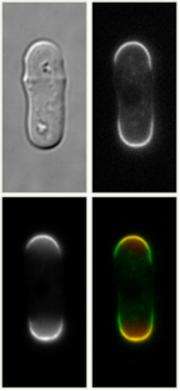A signal change for antifungal agents

Chemical-genomic profiling of bioactive therapeutic compounds reveals therapeutically exploitable signaling activity at fungal cell membranes.
While some fungal species, such as shiitake and enoki, are edible, some microscopic species can trigger numerous infections in the human body. Antifungal drugs are the best means to fight these parasitic species; however, because mammalian and fungal cells share many similarities, such as lipid-based membranes, these medications can produce serious side-effects.
Now, researchers led by Minoru Yoshida from the RIKEN Advanced Science Institute in Wako, have characterized the biological properties of theonellamide (TNM), an antifungal natural product isolated from marine sponges1. They found that, unlike typical modes of action, TNM specifically targets ergosterol lipid molecules in fungal cell membranes, not proteins. This bonding interaction rapidly activates a protein called Rho1 to over-produce 1,3-β-D-glucan sugar chain molecules—a process that forms an aberrant fungal cell wall. This unique mechanism promises to spur development of innovative antifungal agents. “We believe that TNM is the first compound that activates membrane signaling molecules by binding to a lipid,” says Yoshida.
Despite previous efforts to identify TNM’s specific biological actions, its sub-cellular targets were unknown until now. Yoshida and colleagues used a yeast complex to generate nearly 5,000 ‘open reading frames’ (ORFs), which are long strands of DNA that can encode proteins. This was to screen for sequences with altered susceptibility to TNM—so-called ‘hit genes’. Extensive bioinformatic analysis of the chemical-genomic profiles showed that the hit genes showed traits related to sterol binding, Rho-type protein activation or inhibition, and 1,3-β-D-glucan synthesis. However, none of the hit genes showed any physical interaction with TNM, demonstrating that proteins were not the primary target of this molecule.
By synthesizing fluorescently labeled TNM derivatives and comparing their in vivo localization to filipin molecules—known membrane-binding compounds—the team discovered that TNM directly targets ergosterol and related sterols in fungal cell membranes (Fig. 1). Attachment of TNM to these lipid molecules enhanced 1,3-β-D-glucan synthesis—but only in the presence of Rho1, confirming the unprecedented signaling behavior. Further experiments on Rho1 mutants determined that TNM can independently lower membrane integrity, gradually inducing lesions into the cellular structure.
The researchers’ next task—unraveling the complex mechanisms of TNM-induced membrane signaling—may throw light on how to avoid unwanted side-effects in humans during antifungal treatments. “TNM binds to not only ergosterol but also cholesterol, a mammalian counterpart,” explains Yoshida. “Our preliminary findings show that mammalian cells rapidly and transiently change morphology upon TNM treatment—making this compound a fabulous tool to dissect the function of membrane sterols in general.”
More information: 1.Nishimura, S., Arita, Y., Honda, M., Iwamoto, K., Matsuyama, A., Shirai, A., Kawasaki, H., Kakeya, H., Kobayashi, T., Matsunaga, S. & Yoshida, M. . Nature Chemical Biology 6, 519-526 (2010).
Provided by RIKEN
















